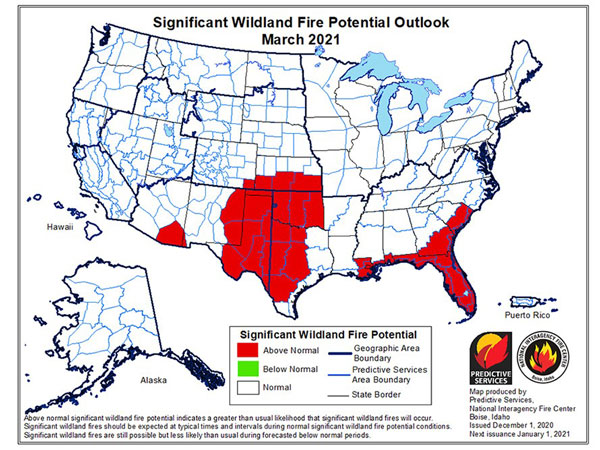The prescribed burning season in Kansas has started. Be careful - the outlook for potential wildland fire in Kansas is above normal for parts of Kansas (Figure 1). Dry moisture conditions in Kansas, along with adequate fuel, increases the chances of wildfire when coupled with warm temperatures, high winds, and low humidity. Counties have issued burn bans already this year. The National Weather Service (NWS) is also issuing Red Flag Warnings. Criteria for a Red Flag Warning can vary somewhat depending on the location, but usually indicate conditions where control of fire will be difficult. For instance, winds gusting to over 25 miles per hour, along with warm air temperatures, and relative humidity less than 25% will often result in a Red Flag Warning this time of the year. The Wichita NWS uses a Grassland Fire Danger Index to communicate fire-weather conditions.

Figure 1. Potential wildland fire outlook for March 2021.
If you are planning to burn this spring, be sure to know your local regulations. Kansas regulations require the person conducting the burn to:
- notify the local fire authority,
- not create a traffic safety hazard,
- not create an airport safety hazard, and
- insure that the burning is supervised until the fire is extinguished.
Your county may require a burn permit. Always check with local authorities to ensure burning is allowed before staring a prescribed burn.
Weather forecasts and smoke model
Weather forecasts can be obtained from the NWS offices in Topeka, Wichita, Dodge City, Goodland, Hastings, NE, Kansas City/Pleasant Hill MO, and Springfield, MO. Online, simply type weather.gov/ and the name of your NWS office.
Weather conditions for conducting a safe prescribed burn are:
- wind speeds 5-15 mph,
- 40-70% relative humidity, and
- air temperatures of 50-80oF.
The amount of cloud cover and mixing height will influence smoke dispersal. Check under the hourly forecast to see what is expected. That hourly forecast is also helpful to see when wind shifts might occur.
A smoke model located at ksfire.org predicts the direction smoke from a fire will travel based on current weather conditions, location, date, amount of fuel, and size of area to be burned. Another site providing useful information relative to conducting a prescribed burn is the Kansas Mesonet. You can see current humidity and wind directly at mesonet.ksu.edu/fire/rh at 70+ locations across the state.
Make sure prescribed fires are completely extinguished
With recent dry weather, mopping up your prescribed fire is critical. Numerous rekindles have been responsible for wildfires throughout eastern Kansas in the last week. Be sure to know the weather forecast for the next days after the burn. The best burning conditions often occur in advance to days with strong winds and low humidity. These unfavorable conditions can cause a flare-up to occur from smoldering objects such as dead wood that can burn for a long time.
Walt Fick, Rangeland Management Specialist
whfick@ksu.edu
Christopher Redmond, Mesonet Manager
christopherredmond@ksu.edu
Mary Knapp, Assistant State Climatologist
Mknapp@ksu.edu